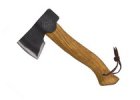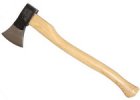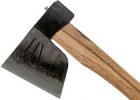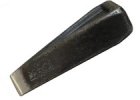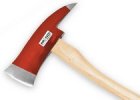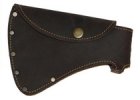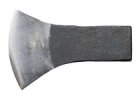Axes
Axes from reputable global manufacturers such as Hultafors, Prandi, CRKT, Condor, and Morakniv. Despite being one of the oldest tools known to man, axe remains an essential piece of equipment for cottages, gardens, construction sites, rescue teams, camping trips, and lot of other activities.
There are various types of axes available, made from different materials and coming in different lengths, weights, and shapes, each with its own unique purpose. For instance, the camping axe is a smaller outdoor ax that is ideal for carrying in a backpack. On the other hand, the splitting axe is a larger, more powerful ax that is well-suited for splitting wood. Finally, there is the universal felling axe which strikes a balance between the two and can be used for a wide range of tasks.
Product sorting
List of products
How to choose an axe?
To choose the right axe, the first step is to determine what you will be using it for. Once we know your needs, we can provide you with the best advice for your specific use case. When selecting an ax, the shape, length, and weight of the blade are the most critical factors to consider.
Types of axes
The shape of the blade plays an important role when using an ax for chopping, splitting wood, felling trees, or other less common activities such as throwing or fighting. Some of the most common types include the camping axe, forest axe, carpenter's axe, splitting axe and splitting maul or carving axe. You may also come across unique shapes like the tomahawk, double-sided axe, adze, firefighting axe, and many others.
Hatchet or hand axe is the lightest and smallest type of ax, weighing under 1 kg and measuring under 40 cm, making it ideal for outdoor activities and basic tasks like preparing small pieces of firewood and chopping.
Felling axe (or forest axe) is an universal axe. Weighing usually 1 - 2 kg and measuring up to 70 cm, is the perfect choice for use at cottage or garden. Made to be used for everything from felling large trees to limbing small logs.
Carpenter's axe, featuring a special blade shape is designed for use in traditional woodwork, joinery, and log house building.
Splitting axe, with a length of approximately 60 cm, is used for splitting and processing smaller logs.
Splitting maul is the largest type of axe, weighing 3 kg or more, with a wedge blade that can handle even the largest logs. Back side of the ax serving as a hammer for the wood splitting wedge.
Axe head and handle material
When it comes to choosing an axe, it's important to consider the materials used in both the head and handle. Head should be made of high-quality steel, which provids a durable edge that can withstand heavy use. Carbon steels like 1045 or 1060 are a popular choice due to their excellent balance of toughness and durability. For those looking for a luxury option, axes made with Damascus steel are also available.
As for the handle, hickory wood is a favorite material due to its flexibility, durability, and ease of replacement if needed. However, it is important to note that wood handles may be more susceptible to weather and mechanical damage. Plastic handles, on the other hand, offer a lighter weight, firmer grip, and resistance to external damage, but usually can not be replaced if broken.
Axe weight and length
Weight and length are also important factors to consider when choosing an axe. Heavier axes are suitable for chipping and splitting larger pieces of wood, while lighter axes are better for travel, bushcraft, and camping. Longer axes provide a greater swing and are useful for heavier tasks, but may be more difficult to handle for smaller tasks. In any case, it's important to choose an ax that fits your needs and abilities for optimal performance and safety.

